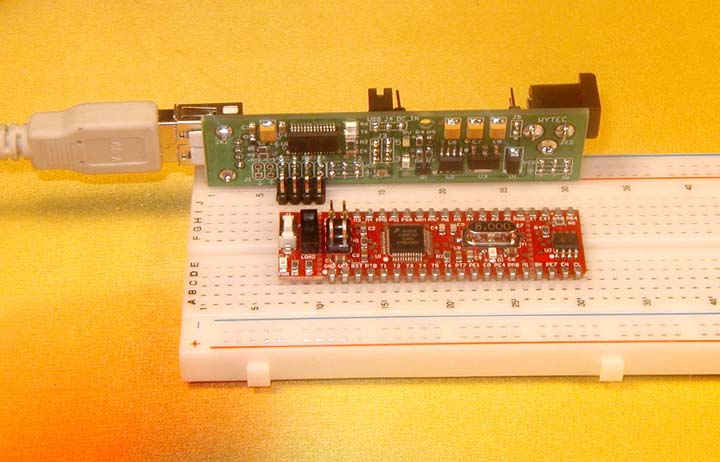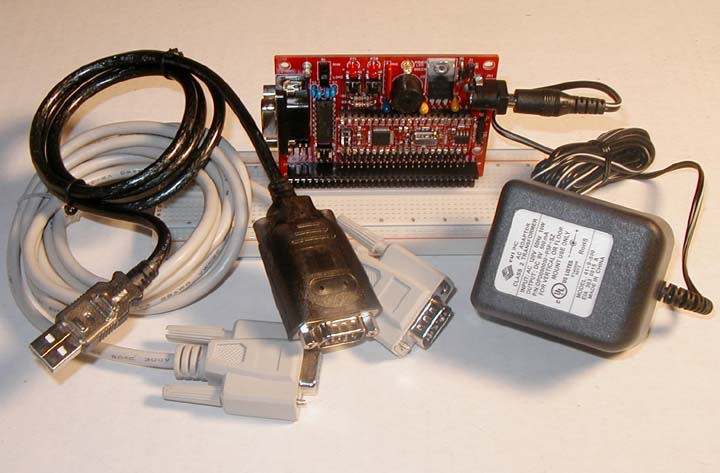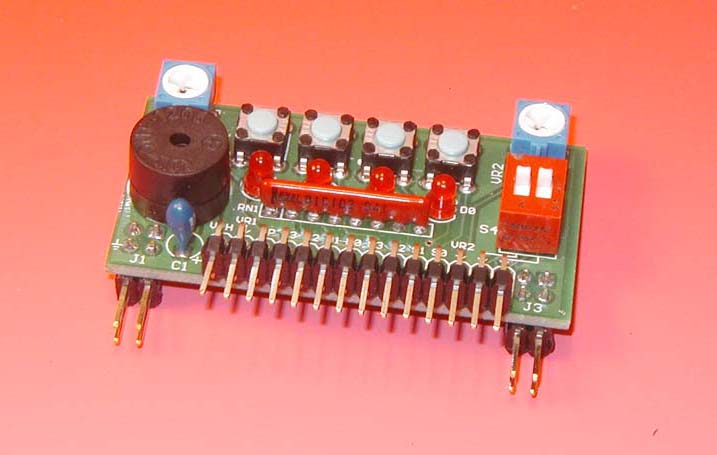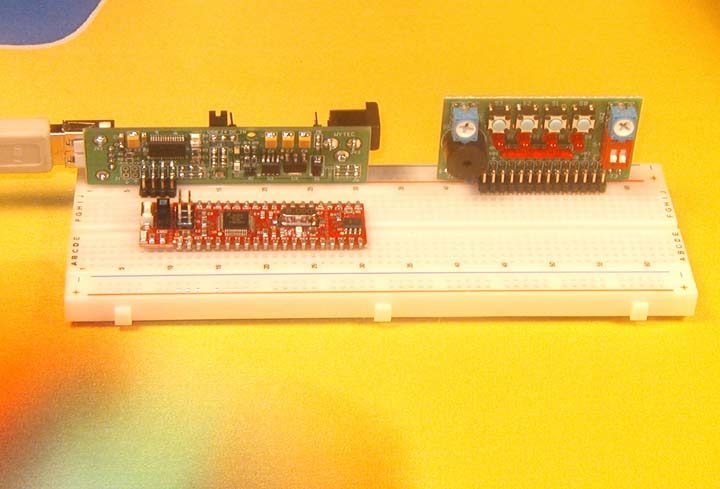|
Question #1: Why
should I select the HCS12 / 9S12 family?
Answer:
- Freescale has dominated university programs since the 1980s. Many professors
have taught 6800, 68HC11 and 68HC12 courses so it's easier to migrate to the HCS12 /
9S12 than to other microcontroller families. Programs written for
those processors will run on the HCS12 / 9S12 without any modifications or
with only minor changes in register and memory addresses.
- HCS12 / 9S12
microcontrollers that are used in EVBplus trainers are
powerful
16-bit CPUs at 24MHz bus speed with 256K flash, 12K RAM, 4K EEPROM, and great on-chip hardware
resources including PWM, ADC, SCI, SPI, I2C, CAN,
and TIMERs. If you choose a controller with a small memory
size, your students may encounter problems
pertaining to memory usage
and they have to pay close attention on memory usage and stack
overflow every time they modify their code. Instead of learning
microcontroller architecture and programming, your students may
have to struggle for fitting their program code into the small
memory size. A small low cost controller with a tiny amount of memory and I/O is beautiful in a
commercial design, like a garage door opener or a microwave
oven, but will limit
what your students can learn in the class and particularly
penalize some students whose bright ideas can be killed and
potentials cannot be fulfilled. If we all are building very simple
applications in the classroom, all controllers might seem equal in the final
result,
but when the demand increases for on-chip memory size
and I/O resources in a more advanced course, the HCS12 family will truly stand out from the
crowd. You will really appreciate the
potential
of the HCS12 / 9S12 family.
- HCS12 / 9S12 microcontrollers come with a clearly defined, powerful
instruction set that is easy
to understand, easy to use and easy to memorize. No other controllers come
even close and
nothing better than starting with a well organized instruction
set for a freshman to learn embedded programming.
There are many microcontrollers with different
architectures available to be chosen from, but however the goal in the class is to understand how microcontrollers
work and build some applications using them in a short period of
time. The easiest
to use microcontroller is of upmost importance, and price and physical
size of a microcontroller really is unimportant.
- Freescale
offers the best debugging tools for execution monitoring and source-level
debugging at no charge, drastically decreasing development time. That
really sets the HCS12 family apart from others
controllers. The HCS12 / 9S12 chip comes in a large 112-pin LQFP
package and while it may cost more than some of the other small
microcontrollers, coupled with the savings from rapid development, the
total system cost is very cost effective. Freescale's D-Bug12
monitor and industrial grade Code Warrior licenses are free and are much
easier to use than any other ASCII-based debuggers and development
environments available.
|
|
Question #2: Why
should I select a EVBplus trainer?
Answer:
-
EVBplus trainers are
high-quality products with great features at a reasonable price.
- EVBplus trainers are popular in
universities and textbooks for EVBplus trainers
are easy to find.
- Course material such as lab manuals, lab assignments and
sample programs for EVBplus trainers are available on many university web sites.
If you are thinking about starting a new HCS12 course,
these sites
offer sample programs in course materials and lab
assignments that will save you a lot of time.
- Excellent, quick
technical
support is available via phone or email. During business hours, you can
talk to a real person over the phone, not an answering machine. With
EVBplus, you will get answers immediately without having to wait days or
weeks.
- We provide our trainers to
many
universities and students, so we keep many trainers in stock for quick
delivery. EVBplus trainers are developed and made in the USA.
-
EVBplus
trainers are highly reusable. Many trainers with limited
functionality designed for a simple course are often put
in closets after the course is over, but with many hardware
features available on EVBplus trainers quite a few students will
continue to use them on the job or in the field after completing training.
-
EVBplus provides
a one-year limited warranty and a 30-day money back guarantee
for all products.
|
|
Question #3: Which
EVBplus trainer should I select?
Answer:
There
are typically two different teaching styles among professors. Some
professors prefer (1) all-in-one boards while others prefer (2) minimal systems
that allow students to easily add hardware on solderless breadboards. We have trainers that are perfect for either approach:
- If your students cannot
construct all hardware circuitry for different lab assignments due to time
constraints in a short course or the focus of the course is embedded
software development, then we recommend our Dragon12 Plus-USB
or
MiniDragon-Plus3 board to teach embedded systems. All hardware
components are already on the board when a
course starts and there will be no time wasted on debugging any unproven
hardware circuitry.
If embedded systems is taught in more than
one class, the Dragon12-Plus-USB board supports both a simple introduction to
embedded systems as well as a more sophisticated embedded systems lab
including CAN, I2C, SPI, DAC, motors and servos. In the simple
introductory course, your students can still build simple application
circuits on the breadboard included with the Dragon12-Plus-USB board. More
advanced courses can take advantage of the Dragon12-Plus-USB' additional hardware features.
Students can also use an all-in-one board for senior design projects.
The on-board versatile hardware peripherals are helpful in quickly and
efficiently developing advanced projects. This is one advantage of selecting an all-in-one trainer. There are several
examples where students have used EVBplus's training boards in the field
while taking an embedded course. OIT student A. Raydt Vaz, for
example, created an Instrument Validator to validate a manufacturing process and improve productivity for his employer.
You can see
his project at the end of the page at:
http://www.almy.us/classes/spr09.html. His
employer has already received a great
return on investment from his education before he even
finished the course -- they'll be approving his next tuition reimbursement
request!
-
If hands-on
experience is a high priority in your course and your student will have
enough time for constructing all required hardware circuitry during the
semester then we recommend our ThunderBird12
or Dragonfly12-Plus DIP module with
our RoadRunner USB+POWER stick.
This is a 'STAMP' type minimal system that allows students to easily add
hardware on a solderless breadboard. It costs less than
an all-in-one board and there are few I/O devices on the module itself. Rather, the students are responsible for designing, implementing
and testing all external hardware devices connected to the module on a solderless breadboard. This minimal system allows students
to experience
the hardware in a real and physical sense. Students gain hands-on
experience and learn how to debug hardware failures while debugging their software.
Students can also use the minimal system for senior
design projects in which a small physical size is required. This is one advantage of selecting
a minimal system.
Our new minimal system can be powered from a USB port and it
eliminates a clumsy DB9 RS232 cable, a USB to RS232 adapter and
a bulky AC adapter. The cost of the RoadRunner is even
lower than some USB to RS232 adapters on the market.
Below is the comparison of our new Dragonfly12-plus with a RoadRunner stick to our old Dragonfly12
prototype system using a docking board.
 |
 |
|
|
|
Our new USB based Dragonfly12-Plus
prototype system
|
Our old Dragonfly12 prototype system
|
|
|
Our minimal system can be expanded
by adding low cost plug-in
modules and those modules can be bought in a kit form that students
can gain hand-on experiences further by assembling the kits. Those plug-in modules are highly
reusable and most
likely will be used by students again in their future projects.
 |
 |
|
|
|
Plug-in I/O module
|
Our new Dragonfly12-Plus prototype system with
an I/O module
|
|
|
|
|
Question #4: Which
board should I select if I want to start a robot course?
Answer:
We have developed a new product, the new MiniDragon-Plus3 multipurpose trainer, offering a
combination of a Robot controller and a versatile trainer board.
If you are going to teach a
robot course the MiniDragon-Plus3 is a good choice. Not only it can be
used
for a real robot competitions, but also it can be a general trainer and your students can create many amazing projects that require a small board.
|



